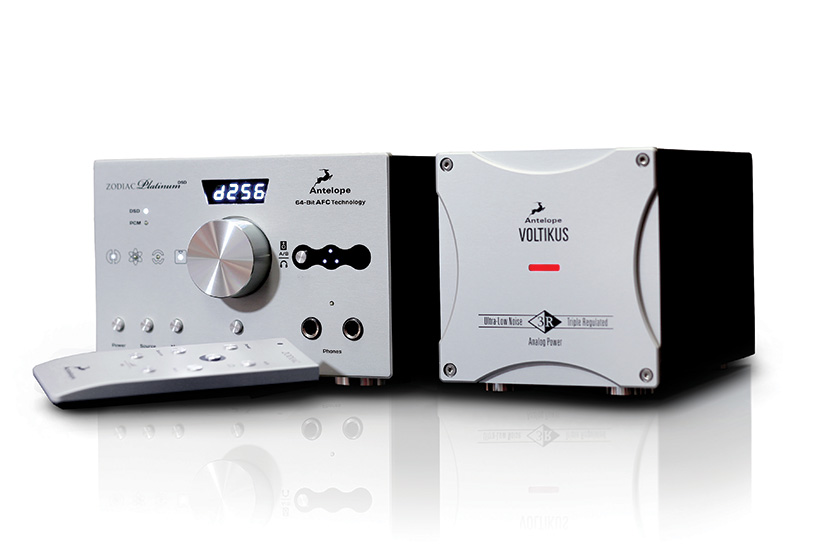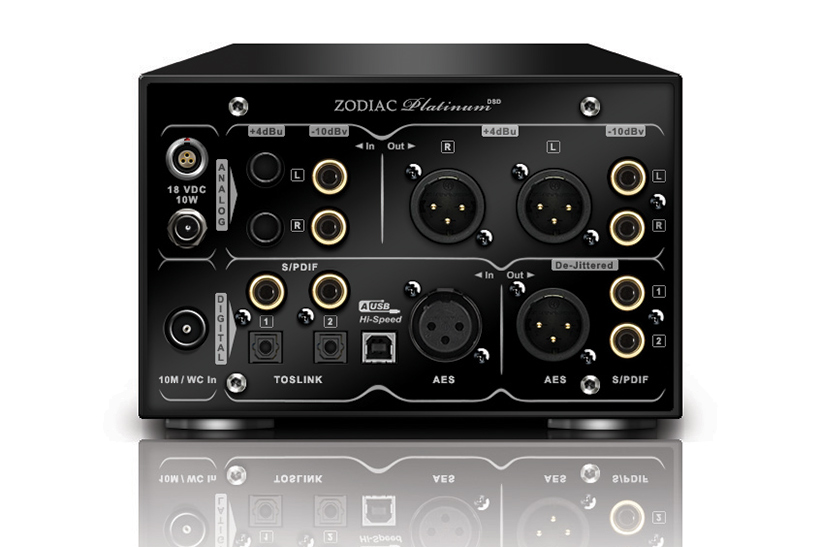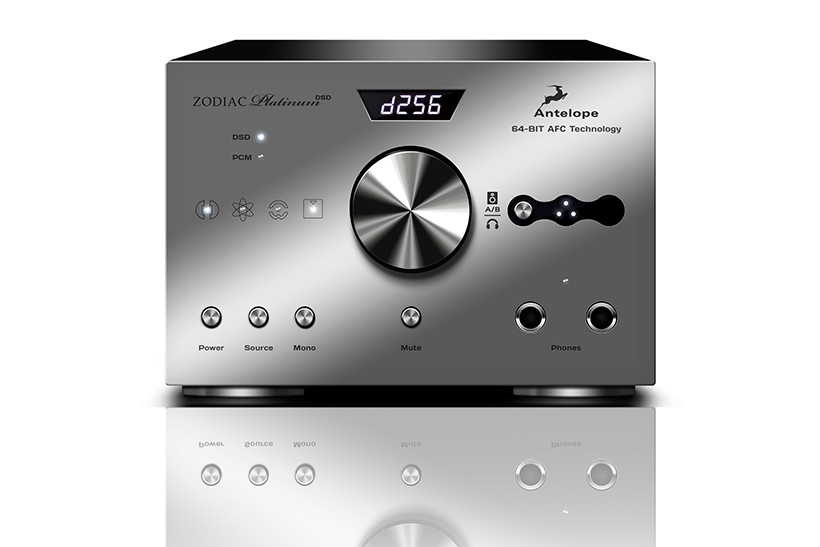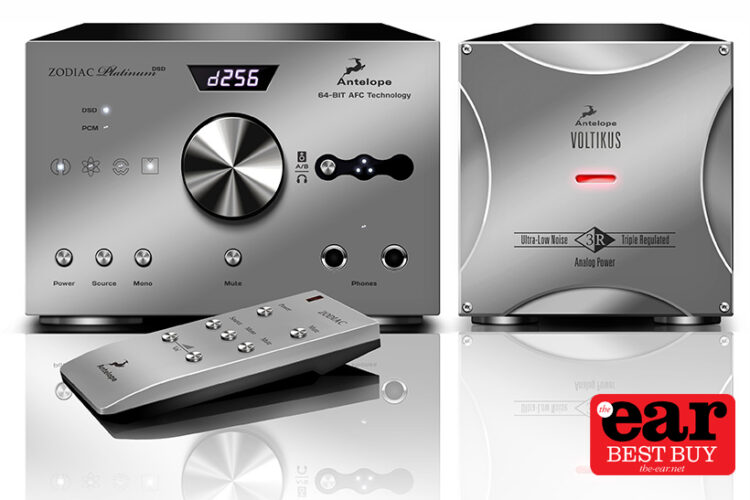An almost cubic DAC with a knob on it, from Bulgaria, with my reputation? Not half. Turns out that Antelope Audio has its origins in the US but all the R&D and marketing comes from Sofia, so Bulgarian enough then. I tried the first Antelope converter (now dubbed Zodiac 192 kHz) when the digital streaming malarkey was making the first inroads into the high end, at the time it managed to make a Bryston BDP-1 digital transport sound pretty exhilarating.
Antelope are primarily involved in pro audio where they specialise in hard core studio clocks, atomic clocks that synchronise multiple devices. Someone must have told them that hi-fi nuts would go for their stuff and they launched the Zodiac range of converters which was followed by clocks for the same. Now, at the top of the tree, they have the Rubicon Atomic AD/DA preamplifier, a positively baroque looking creation that incorporates a rubidium clock. I bet it’s good though.
The Platinum DSD is the highest specced version of the Zodiac DACs, it supports PCM up to 384kHz and DSD up to 128x. It uses the popular DSD over PCM (DoP) system which fools computers into streaming DSD, and converts directly from DSD to analogue, avoiding any PCM stage in between. Antelope’s engineer Igor Levin can be found on YouTube talking about this DAC and one of the points that he gets most enthusiastic about is the upsampliing. This process is usually done within the DAC chip, it’s a standard function of modern converter chips hence very common in all manner of players. However the implementation is necessarily compromised by cost, power and heat factors. So Antelope has created its own upsampler using FPGAs which runs at 64-bit, so it should be considerably more refined than the standard 24-bit varieties. Differences between the Platinum DSD and the Gold that it surmounts in the range include a 10MHz clock input so that you can upgrade with one of Antelope’s clocks, an external Voltikus 2 power supply and quieter relays on the volume control. It uses two DACs per channel in a dual differential mode to minimise noise and achieve maximum channel separation.

The Platinum DSD’s back panel is choc full of connections including balanced and single ended outputs, an analogue input and five digital inputs plus USB, there are also three digital outputs. It’s pretty comprehensive albeit missing a BNC for coaxial S/PDIF connections, given that this is the only true 75 Ohm connection available for coax this seems an oversight. I guess if you are really serious then the AES/EBU input is the one to go for. The front of the unit gives access to all these in and outputs but not always in the clearest possible way. There is for instance a row of symbols that you have to interpret; from left they are signal lock, atomic clock lock, word clock lock and mono. So unless you add a separate clock only two are relevant, which helps, what baffled me was that mono mode is brought on by pressing the biggest, yet unnamed, button on the remote handset. On the right there are three lights next to a switch and a slightly cryptic symbol with headphones beneath it. Pressing this switch changes output from balanced to unbalanced to headphone outputs (two of which are below). Having so many variable made it a little tricky to get the Platinum DSD up and running with a USB source, that and the need to download Antelope’s driver and control panel. The latter being required on both Apple and Windows computers.
However with some help from the immensely patient Geri in Antelope’s tech support department I was able to get the DAC working in USB2 mode and could get spinning with Audirvana Plus playback software on my Macbook Air. Last time I used the Audirvana software it slightly trailed the Decibel player that I’ve been using for a while. That is no longer the case, the 1.5.12 version is clearly superior to Decibel and by extension all the other software players I have access to. It images spectacularly well, but then this DAC will have something to do with that of course. The system, with the aid of Vivid G3 speakers, produced an intensely real presence in the room, voices in particular sounded very convincing. The sheer quantity of detail is staggering and this did not change when I switched to some DSD material. In this case Weather Report’s Birdland (Heavy Weather) was rendered with a nimbleness and lightness of touch that was inspiring. Next up was a .DSF version of Rolling in the Deep (Adele, 21) which caused the word ‘woah’ to pass my lips. This brought on by the complexity and power of the kick drum and the emotional power of the voice, it proved a stirring experience that was for once not ruined by the compression applied to the chorus. It’s not hard to hear why this singer has made such a huge impression in such a short time, she certainly made an impression on me with the Antelope DAC.

Visions of Johanna by Bob Dylan is rather more subtle but no less great. I was surprised at how good these DSD files sounded, there is none of the unnatural airiness that I’ve encountered with the format in the past. With PCM the results are likewise very fine, Keith Jarrett’s solo Testament recording (London/Paris) puts you very close to the piano, giving a microphone’s ‘eye view’ of the music, complete with him stomping on the stage. The DAC sits you right up there in the thick of it, which makes for a visceral experience that holds nothing back between you and the performer. This level held up through a variety of recordings, the Platinum DSD reflecting the quality of recording with ease and delivering very convincing renditions of well hammered test tracks like Herbie Hancock and Tina Turner’s version of Edith and the Kingpin (River: the Joni Letters).
I also tried the Platinum DSD’s coaxial input using the redoubtable Naim NDS network streamer as a source, a component that only has digital output on BNC. Luckily I have a Chord Co Sarum TA cable with the appropriate plugs to join it to the Antelope because it would have been a pity to have had to compromise matters with an adaptor. This combination proved nothing short of storming, PCM material matching the results achieved with DSD in many respects, bettering them in terms of timing but not perhaps quite achieving the finesse of the best. But it’s very much down to the recordings themselves and it’s great to have the ability to convert both formats, then you’re not limited as to what you play and you can find out which albums on which formats work best for you.

The Antelope Zodiac Platinum DSD is an expensive converter but unlike many it’s also a preamplifier, and equally unlike most it’s both highly revealing and musically engaging when fed a good signal. It also has the option of upgrade with an outboard word clock, something that René found to be very worthwhile indeed with his own DAC. This converter may look unconventional but the flexibility that it offers and the sound it can produce place it very high in the ranks of high end DACs. Even at this price that’s pretty damn impressive.


